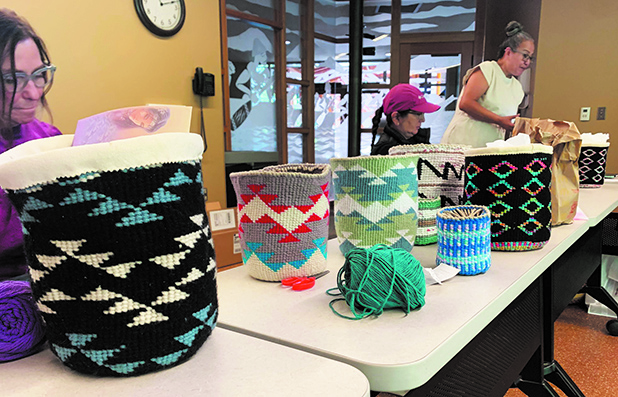
By Shaelyn Smead, Tulalip News
On September 27-28, weaving artist Leanne Campbell, traveled to Tulalip and held a weekend long Columbia Plateau Basketry workshop at the Hibulb Cultural Center. Leanne is Coeur d’Alene, Colville, Nez Perce, and travels frequently to connect and teach twining throughout different tribes in the area.
Twining is a form of weaving that can be used for various baskets, bags, hats, etc. It’s a style of basketry that is very specific to Natives in the Columbia Plateau. When speaking with Tulalip tribal member Rae Anne Gobin, Leanne learned that there are some Colville and Nez Perce descendants within Tulalip, and thought that they might find the class interesting. But no matter who showed for the class, Leanne was excited and found this opportunity of teaching at Hibulb an act of preservation for traditional arts.
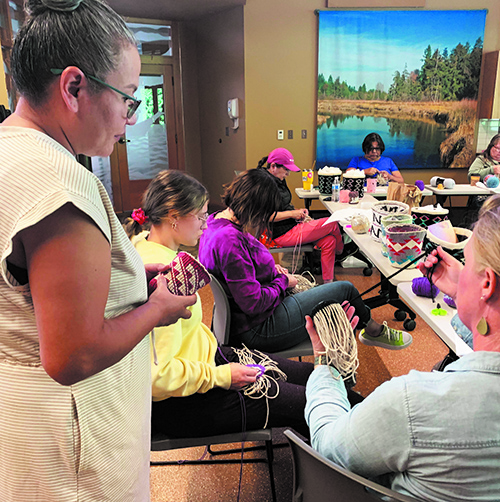
Leanne first picked up weaving in the late 90s and didn’t start teaching until the mid 2000s, when she was asked to demonstrate at a weaving conference. From there, she branched out and began traveling more, offering her Columbia Plateau Basketry workshops, teaching at the Hazel Pete Institute, and participating in weaving conferences. When teaching workshops, Leanne provides basketry kits that are available for purchase, that way everyone can have the supplies that they’ll need to learn.
The class was filled with people from all walks of life. Some of those in attendance were Tulalip tribal members, Tulalip community members, Natives traveling from other tribes, and people from the general public. Traveling the furthest were Siletz tribal members, Charlene Holycross and Nadia Mosqueda, from Oregon. This mother and daughter duo have been following Leanne for quite some time and even traveled to see her in Idaho. They originally had connected with her through Facebook, and had won a hat that Leanne was raffling off. Since then, they’ve been dedicated students, absorbing as much knowledge as they can.
“After I get the basics down, I want to start learning our Siletz baskets,” Nadia said. “Our tribe traditionally weaves with materials like fern, bear grass, and hazel root, so eventually I’ll be able to work my way towards that. But Leanne is such a great teacher and I love the designs she teaches, and hopefully I can incorporate them into our hats.” Nadia also spoke of her weaving journey and how none of it would’ve existed without inspiration from her mom, Charlene.
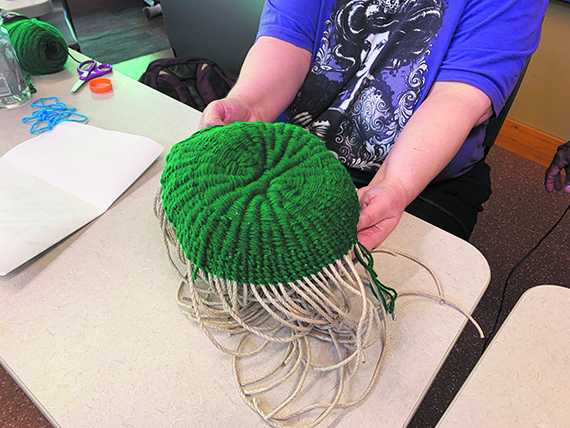
“I’m not going to be here forever,” said Charlene. “You try to teach your kids and it can only go so far sometimes, but with the help of teachers like Leanne, her guidance has really helped. I love the time that I’ve been able to share with my daughter and even though it’s not our traditional style of weaving, I’m excited to use it with everything we have back home. I hope that this art can continue in my family.”
With the creation of organizations like Northwest Native American Basket Weavers Association, the Okanagan Basket Weavers, and many others, artist are able to travel to other tribes to learn from them and also share their craft.
“This style of basketry is one that we were starting to see a decline in the number of people still doing it,” Leanne expressed. “For me, being able to teach this will help revitalize this traditional art and help keep it going. That’s what’s great about conferences, we all get to learn from each other. No matter what tribe we’re from, or what we’re sharing with each other, every tribe brings so much value and purpose, and it’s important that we keep traditional art alive.”
Leanne also spoke about how our cultural learnings can go beyond just what is in our tribe. But as Native Americans, we can learn so much from each other, and work together to keep our cultural practices strong.
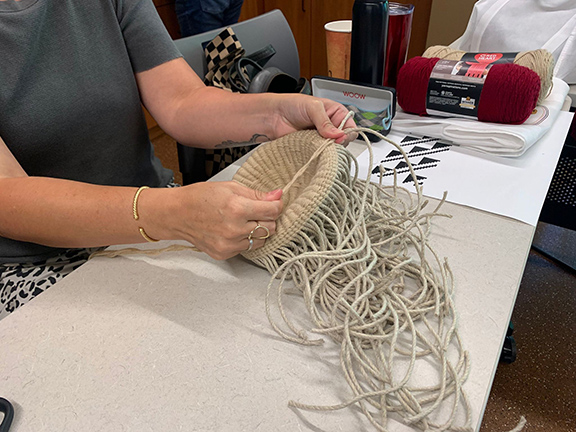
Traditionally, Native Americans have taught each other different teachings from one generation passing down to another. With the advancement of technology, learning new skills like weaving have become so accessible. People are connecting with other artists on social media, watching tutorial videos online, and promoting conferences and/or events to increase awareness. Since then, new forms and styles of teaching have also expanded. Even new and modern-day materials are being introduced to these traditional skillsets. Some use contemporary materials like hemp twine, acrylic yarns, and wool that are typically more accessible are being used as an adaption to our modern world.
No matter the material, it’s important to remember the cultural significance behind weaving. Leanne said, “Anyone could look at the baskets we make and say ‘oh that’s just a basket.’ But basket making is such a time perfected technique that has been passed down countless generations and for that traditional art to survive, it really speaks to the resiliency of that art to transform to modern time and modern materials,”
The room was filled with concentrated intentions, collaborative storytelling, and amusement in their shared mistakes. One thing Leanne kept mentioning, is the importance of patience, and kindness to yourself whenever you’re taking on a new skillset.
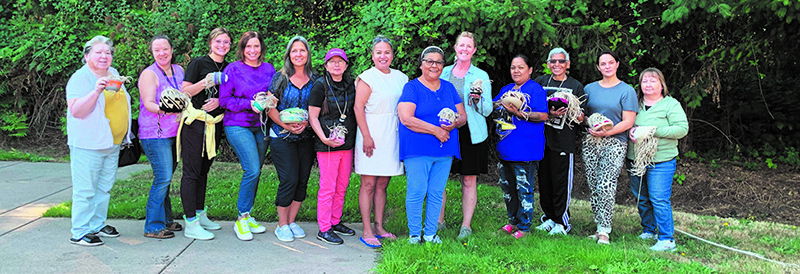
She also spoke on the cultural importance behind the baskets. How even though it is an art form to be able to make a basket, to remember that these baskets have purpose. “Baskets are a part of food gathering practices, landscape, and seasons. When teaching, it’s also important to remind everyone of the cultural importance, and the celebration of our first foods,” she said. “Being able to work with other tribes and bond over these practices is very special.”
Leanne expressed extraordinary gratitude towards the Tulalip community, the hospitality they provided and the opportunity to teach at such a beautiful cultural center, and hopes one day she’ll be able to teach there again soon.
The Hibulb Cultural Center continually brings in talented Native artists, be sure to stay updated and on the lookout for future events at /www.hibulbculturalcenter.org/Events.